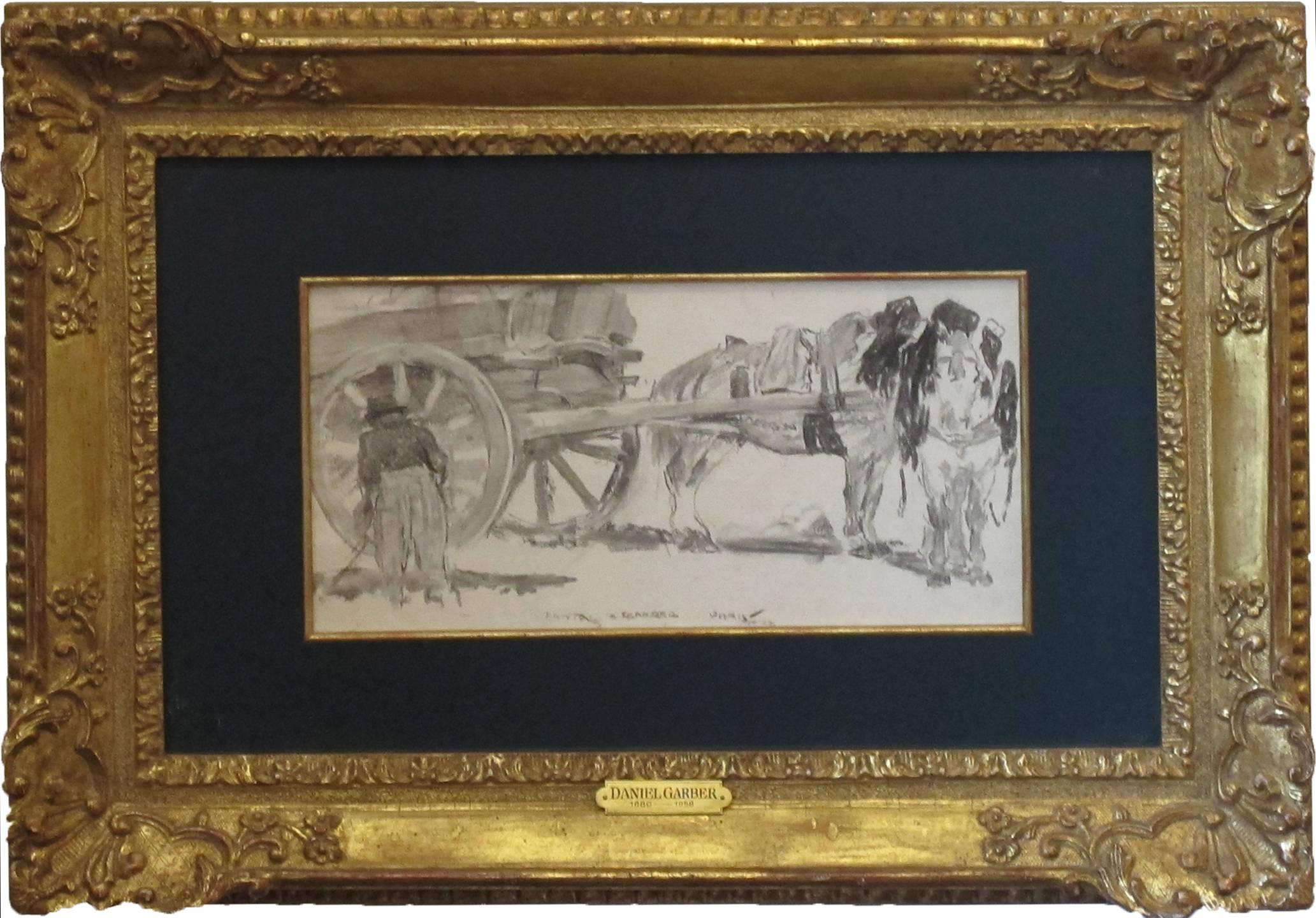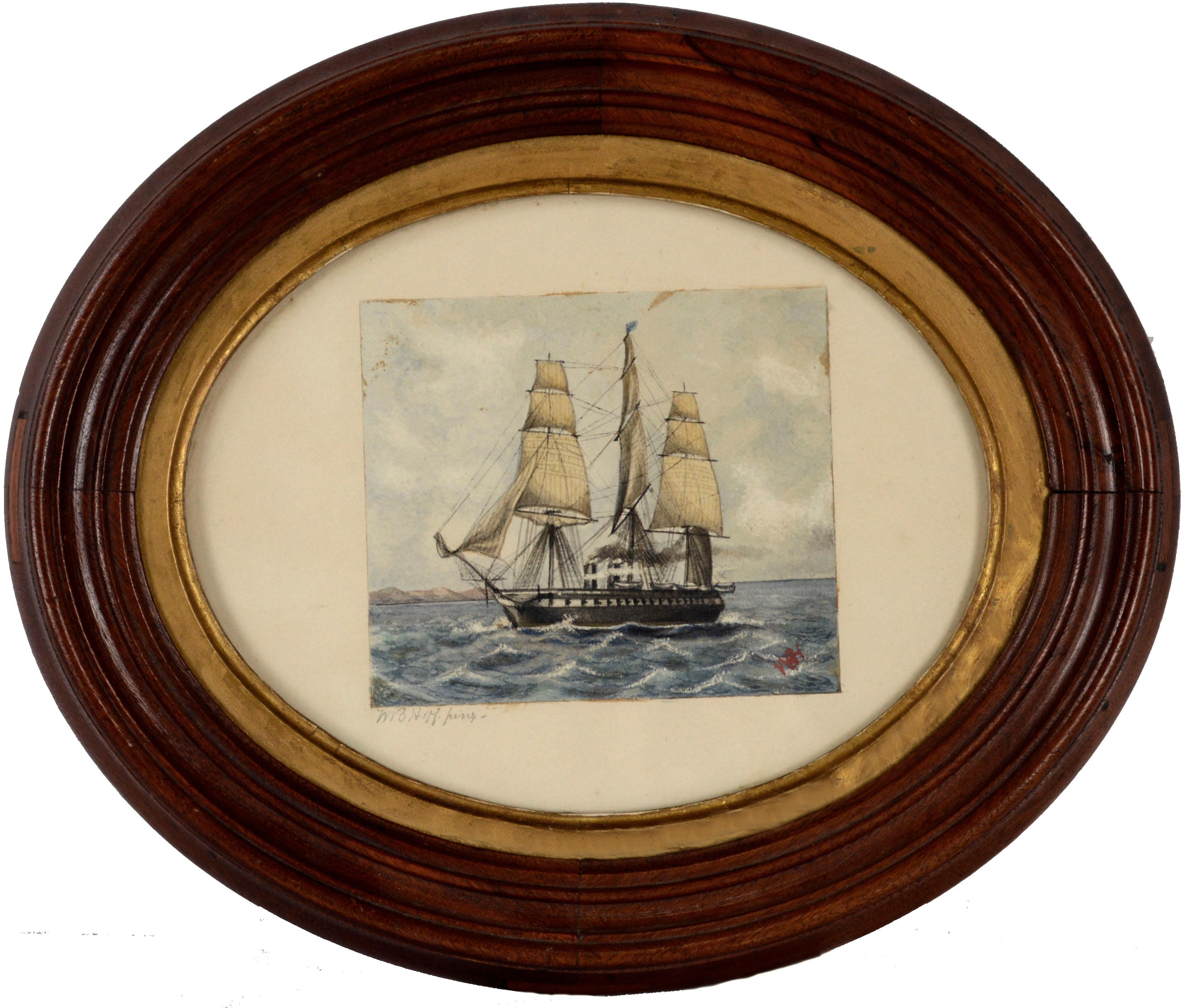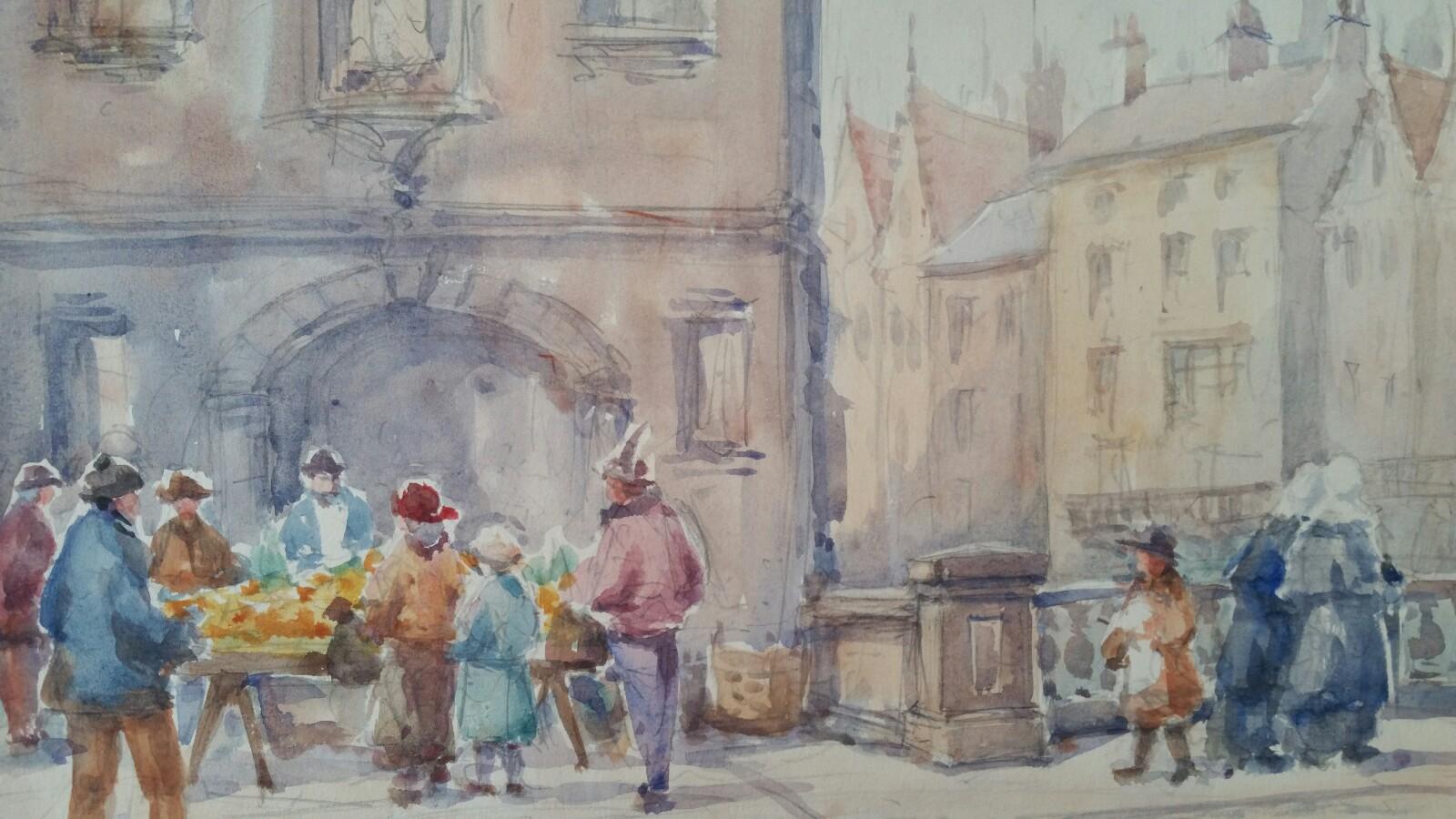Items Similar to Beauregard House, New Orleans
Want more images or videos?
Request additional images or videos from the seller
1 of 3
Louis Oscar GriffithBeauregard House, New Orleansc. 1916
c. 1916
About the Item
Louis Oscar Griffith (1875-1956) was an American painter known for his etchings, paintings, and aquatints of landscapes, especially scenes of Brown County, Indiana, New Orleans, LA and Texas. Griffith was born in Indiana in 1875 but later moved to Dallas, TX with his family. As a teen, he took art lessons with acclaimed landscape artist, Frank Reaugh. He then studied at the St. Louis School and Museum of Fine Arts before moving to Chicago in the mid-1890s to study at the Art Institute and work as a commercial artist. In the winter of 1916, Griffith came to New Orleans to paint and sketch with fellow artist Robert Grafton. The impressionist sketches and paintings they did of the French Quarter and the Basin St. canal and docks are coveted not only for their beauty and skill but for the preservation of a bygone era.
- Creator:Louis Oscar Griffith (1875-1956, American)
- Creation Year:c. 1916
- Dimensions:Height: 9.12 in (23.17 cm)Width: 13.12 in (33.33 cm)
- Medium:
- Movement & Style:
- Period:
- Condition:
- Gallery Location:New Orleans, LA
- Reference Number:1stDibs: LU2265211639442
About the Seller
No Reviews Yet
Vetted Seller
These experienced sellers undergo a comprehensive evaluation by our team of in-house experts.
1stDibs seller since 2022
6 sales on 1stDibs
- ShippingRetrieving quote...Ships From: New Orleans, LA
- Return PolicyA return for this item may be initiated within 7 days of delivery.
More From This SellerView All
- Bayou with Oaks and CypressBy Alexander DrysdaleLocated in New Orleans, LAAlexander John Drysdale (1870–1934) was an early 20th-century artist who specialized in landscapes of Louisiana using the technique of oil wash...Category
Early 19th Century Landscape Paintings
MaterialsPaper, Oil, Board
- TruthsLocated in New Orleans, LASophia Lauer has a degree in both fine art and film from Lipscomb University and has worn many hats in the Nashville arts scene. Her creativity continues to be expressed through many...Category
21st Century and Contemporary Abstract Paintings
MaterialsPaper, Acrylic
- French Quarter CourtyardLocated in New Orleans, LAFrench Quarter CourtyardCategory
Early 20th Century Interior Paintings
MaterialsPaper, Watercolor
- White DotsLocated in New Orleans, LASophia Lauer has a degree in both fine art and film from Lipscomb University and has worn many hats in the Nashville arts scene. Her creativity continues to be expressed through many...Category
21st Century and Contemporary Abstract Abstract Paintings
MaterialsPaper, Acrylic
- WomanLocated in New Orleans, LASophia Lauer has a degree in both fine art and film from Lipscomb University and has worn many hats in the Nashville arts scene. Her creativity continues to be expressed through many...Category
21st Century and Contemporary Abstract Abstract Paintings
MaterialsPaper, Mixed Media
- Untitled AbstractBy Allison StewartLocated in New Orleans, LAStewart has exhibited extensively throughout the United States and is represented by the Arthur Roger Gallery in New Orleans, Gail Severn Gallery in Sun Va...Category
1980s Abstract Abstract Paintings
MaterialsChalk, Conté, Crayon, Acrylic, Archival Paper
You May Also Like
- "Study off Newport, Rhode Island" John Singer Sargent Drawing, ImpressionismBy John Singer SargentLocated in New York, NYJohn Singer Sargent Study off Newport, Rhode Island, 1876 Signed in pencil "JS265A" lower left Pencil on paper 5 x 10 inches Provenance: Estate of the artist Grand Central Art Galleries, New York, 1959 Mr. William H. Bender Jr Sotheby's New York, September 19, 1987 Private Collection 1987-2000 Mark Borghi Fine Art Inc., circa 2002 Private Collection (acquired from the above), New York Recognized as the leading portraitist in England and the United States at the turn of the century, John Singer Sargent was acclaimed for his elegant and very stylish depictions of high society. Known for his technical precocity, he shunned traditional academic precepts in favor of a modern approach towards technique, color and form, thereby making his own special contribution to the history of grand manner portraiture. A true cosmopolite, he was also a painter of plein air landscapes and genre scenes, drawing his subjects from such diverse locales as England, France, Italy and Switzerland. In so doing, Sargent also played a vital role in the history of British and American Impressionism. Sargent was born in Florence in 1856. He was the first child of Dr. Fitzwilliam Sargent, a surgeon from an old New England family, and Mary Newbold Singer, the daughter of a Philadelphia merchant. His parents were among the many prosperous Americans who adopted an expatriate lifestyle during the later nineteenth century. Indeed, Sargent's family traveled constantly throughout the Continent and in England, a mode of living that enriched Sargent both culturally and socially. He ultimately became fluent in French, Italian and German, in addition to English. Having developed an interest in drawing as a boy, Sargent received his earliest formal instruction in Rome in 1869, where he was taught by the German-American landscape painter Carl Welsch. Following this, he attended the Accademia di Belle Arti in Florence during 1873-74. In the spring of 1874, Sargent's family moved to Paris, enabling him to continue his training there. He soon entered the studio of Charles-Emile-Auguste Carolus-Duran. In contrast to most French academic painters, Carolus-Duran taught his students to paint directly on the canvas, capturing the essence of his subject through relaxed brushwork, a tonal palette and strong chiaroscuro. Although Sargent also spent four years studying drawing under Léon Bonnat at the Ecole des Beaux-Arts, it was Carolus-Duran's approach that would form the aesthetic basis of his style. Upon his teacher's advice, Sargent also traveled to Spain and Holland to study the work of old master painters such as Diego Velázquez and Frans Hals, both of whom also employed deft, fluid techniques. In 1876, Sargent made his first visit to the United States, claiming his American citizenship and visiting the Philadelphia Centennial Exposition. One year later, he spent the summer in Cancale, in France's Brittany region, where he painted outdoors, applying Carolus-Duran's strategies to portrayals of fishing folk on sunlit beaches. His reputation in Paris was established in 1878 when his Oyster Gatherers of Cancale (1878; Corcoran Gallery of Art, Washington, D.C.) won an Honorable Mention at that year's Salon. During the early 1880s, Sargent began making painting trips abroad, working in Venice in 1880 and 1882, where he painted street scenes and interiors notable for their brilliant play of light and shadow. He also embarked on what would be a lucrative career as a portraitist, producing such well known works as The Daughters of Edward Darley Boit (1882; Museum of Fine Arts, Boston). His early commissions also included an image of Madame Pierre Gautreau. A renowned beauty and member of Parisian society, Madame Gautreau was known for her bold, unorthodox approach towards fashion. In her portrait, entitled "Madame X" (1884; Metropolitan Museum of Art, New York), Sargent effectively captured her distinctive aura. However, his daring realism, coupled with fact that he portrayed a diamond shoulder strap falling off one of her shoulders, caused such an uproar that his career in France was seriously compromised. As a result of the controversy surrounding "Madame X,"Sargent left Paris in 1886, settling permanently in London. He subsequently flourished in the English capital, becoming the leading portrait painter to the upper classes. Those who shared Sargent's sense of refinement and sophistication, as well as his international viewpoint, were especially drawn to his fashionable French style. In addition to patronage from such prominent British families as the Wertheimers and the Marlboroughs, Sargent received an equal number of American commissions, many of them secured by artists and architects he had met during his student days in Paris, among them painters J. Carroll Beckwith and Julian Alden Weir and architect Stanford White. On a painting tour to America during 1887-1888, he portrayed members of notable families from Boston and New York, including Mrs. Jacob Wendell and Elizabeth Allen...Category
1870s Impressionist Landscape Drawings and Watercolors
MaterialsPaper, Pencil, Graphite
- "Horse Cart"By Daniel GarberLocated in Lambertville, NJJim’s of Lambertville Fine Art Gallery is proud to present this piece by Daniel Garber (1880 - 1958). One of the two most important and, so far, the most valuable of the New Hope Sc...Category
Early 20th Century American Impressionist Landscape Drawings and Waterco...
MaterialsGraphite, Paper
- "Central Park"By William Langson LathropLocated in Lambertville, NJJim’s of Lambertville is proud to offer this artwork. Signed. Complemented by a hand carved and gilt frame. William L. Lathrop (1859-1938) Deemed “Father of the New Hope Art Colony”, William Langson Lathrop was born in Warren, Illinois. He was largely self-taught, having only studied briefly with William Merritt Chase in 1887, at the Art Students League. Lathrop first moved east in the early 1880s, and took a job at the Photoengraving Company in New York City. While there, he befriended a fellow employee, Henry B. Snell. The two men became lifelong friends and ultimately, both would be considered central figures among the New Hope Art Colony. Lathrop's early years as an artist were ones of continuing struggle. His efforts to break through in the New York art scene seemed futile, so he scraped enough money together to travel to Europe with Henry Snell in1888. There he met and married an English girl, Annie Burt. Upon returning to New York, he tried his hand at etching, making tools from old saw blades. Even though his prints were extremely beautiful, he still was impoverished. Lathrop would return to his family in Ohio, before once again attempting the New York art scene. In 1899, with great trepidation, he submitted five small watercolors to an exhibit at the New York Watercolor Club. He won the Evans Prize, the only award given, and four of the five paintings were sold the opening night. At age forty Lathrop’s career would finally take off and he became an “overnight success Lathrop came to Phillips Mill for the first time in1898, to visit his boyhood friend, Dr. George Marshall. Shortly after, he and his family purchased the old miller’s house from Dr. Marshall. The Lathrop’s home became a social and artistic center for the growing New Hope colony. Tea and fascinating conversation was the “order of the day” every Sunday. This was a scene fondly recalled by many younger art students that Lathrop taught privately at Phillips Mill. It was common to see groups of his students painting and sketching along the banks of the canal or aboard his canal boat. He had previously taught in the Poconos and at the Lyme, Connecticut Summer School in1907, but Phillips Mill always remained Lathrop’s permanent address. In 1928, a committee headed by Lathrop was formed to purchase the old Phillips Mill building as a place to hold community gatherings and art exhibitions. The committee had success and in 1929 the Phillips Mill Community Association was formed. This became the center of the New Hope Art Colony holding annual exhibitions and still operating today. In 1930, Lathrop had built a sailboat he named the “Widge”. For eight consecutive seasons he sailed it along the coast of Long Island...Category
Early 20th Century American Impressionist Landscape Drawings and Waterco...
MaterialsGraphite, Paper
- 19th Century Maritime Seascape, USS Steam Frigate NiagaraLocated in Soquel, CA19th century maritime seascape of a naval ship similar to those used in the war of 1812, by William B. Hoff (American, 1846-1903). This miniature wat...Category
19th Century American Impressionist Landscape Drawings and Watercolors
MaterialsWatercolor, Paper, Graphite
- Preliminary Drawing for the color aquatint "Street Gossip"By Louis Oscar GriffithLocated in Fairlawn, OHPreliminary Drawing for the color aquatint "Street Gossip" Signed by the artist in pencil lower left Graphite on tracing paper, 1916-1917 An impre...Category
1910s American Impressionist Landscape Drawings and Watercolors
MaterialsGraphite
- Mid 20th Century, Belgium, A Gent Morning MarketBy Leonard Machin RoweLocated in Cirencester, GloucestershireBelgium. Gent - A Morning Market by Leonard Machin Rowe (1880-1968) signed and inscribed front lower right corner, inscribed and signed to the back watercolour painting on artist's ...Category
1950s Impressionist Landscape Paintings
MaterialsGraphite, Watercolor





